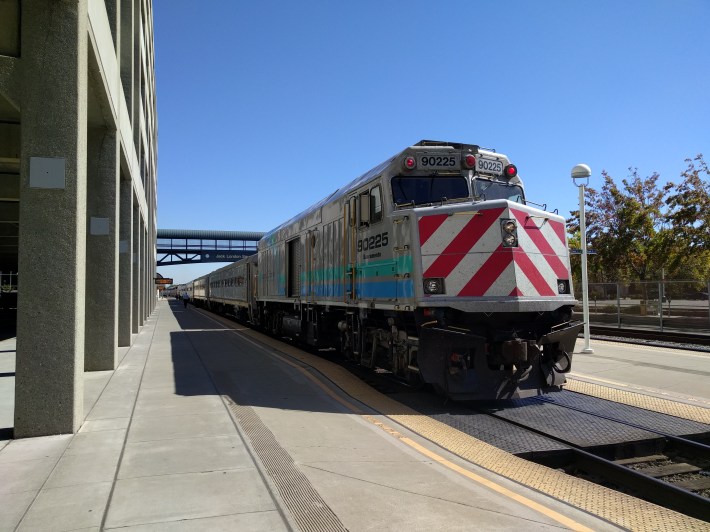The three operating agencies that run California's intra-state Amtrak services have formed a Washington lobbying group called California’s Intercity Rail Corridors Linking Everyone (CIRCLE). From a release about the new CIRCLE consortium, which represents the state's three rail agencies:
Over the last four decades, the state has invested over $3.2 billion in improving its intercity passenger rail network. Pre-pandemic, one out of every five Amtrak riders boarded a train in California. The Capitol Corridor route provides service between San Jose, Oakland, Sacramento and Auburn and is managed by the CCJPA; the Pacific Surfliner route provides service between San Diego, Los Angeles, and San Luis Obispo and is managed by the LOSSAN Rail Corridor Agency; and the San Joaquin route provides service between Bakersfield, Oakland and Sacramento and is managed by the SJJPA.
Combined, the three routes carried over 5.6 million passengers throughout California in Fiscal Year (FY) 2019 and the corridors all respectively rank in the top 10 in ridership in the nation. The LOSSAN corridor is the largest intercity rail corridor in the United States outside of the Northeast Corridor, carrying over 2.5 million passengers annually. The three California routes are responsible for nearly 50% of Amtrak’s state-supported business unit revenue.
In California, trains are operated by Amtrak, but managed and funded by the San Joaquin, Capitol Corridor, and LOSSAN (Pacific Surfliner) agencies. As explained in Trains magazine, Amtrak is supposed to charge these agencies the costs of operating the trains. But disputes over accounting and how those costs are calculated have led to pushback and the formation of CIRCLE.
But Streetsblog hopes CIRCLE will grow way beyond fighting for a better deal with Amtrak.

First, some context on California's trains beyond the PR-speak of the CIRCLE release.
The statement that California's trains have the heaviest ridership outside of the Northeast Corridor (NEC), while technically correct, is a bit absurd. Pre-pandemic, Amtrak carried 12.5 million annually on its NEC fully electrified, multi-track mainline. And that doesn't even count all the commuter railroads that also use that track. Just one branch of New York's MetroNorth railroad carries 40 million people annually on the NEC.
So carrying 5.6 million annually in California, a state with nearly 40 million people, behind slow, belching diesels, is, well, a sad reflection on how bad trains are in America outside of the Northeast. California's trains are comfortable, but they're almost always slower than driving, infrequent, and unreliable--every year tracks are washed out along the coast in Orange and San Diego Counties and replacement buses have to be used. The state's size, population, and wealth are as big as many nations in Europe. But the high-quality rail systems of, for example, Bulgaria, Poland, or anywhere else put ours to shame. That's because the state spent a ridiculously paltry "$3.2 billion on rail over four decades."

California is making a real effort to bring its trains into the modern world with its high-speed program. But perhaps it was a mistake to focus on only the one route between L.A. and S.F. via the Central Valley. After all, the state has three north-south highways: 101 on the coast, I-5 in the middle, and SR-99 to the east via Bakersfield and Fresno. If it has three major, multi-lane highways, so why should it build only the one modern north-south rail line? There is a State Rail Plan, but it's just not ambitious enough.
Perhaps CIRCLE could become the entity that starts to raise the bar for rail by putting together a plan to really modernize rail everywhere in the state and bring it up to European or Japanese standards, as happened over the decades with the Interstate Highway system.
California's transportation budget is $26 billion annually, nearly all dedicated to the automobile. How about spending some of those state billions every year towards multi-tracking and electrifying the coastal route all the way from Sacramento to San Diego with overhead wire, as Caltrain is doing? How about buying fast, tilting trains to help deal with the curves? How about doing some tunneling, to eliminate the sharpest curves? How about moving parts of the alignment that wash out every year? Yes, some incremental, modest, double-tracking is getting done in Orange County and San Diego, but that's taken decades thanks to paltry funds. And some of these plans have been on the books forever.

Too ambitious? Here's something short-term for CIRCLE: follow another European model and restore sleeper trains, so that people can board a train in San Francisco or San Jose, crawl into bed, and wake up in Santa Barbara, Burbank, or Los Angeles (and the reverse going back). That's physically possible to do right now--it's a matter of political will and operational funding.
But that should be just a first step towards a mighty transformation to bring California's rail system up to world standards.






